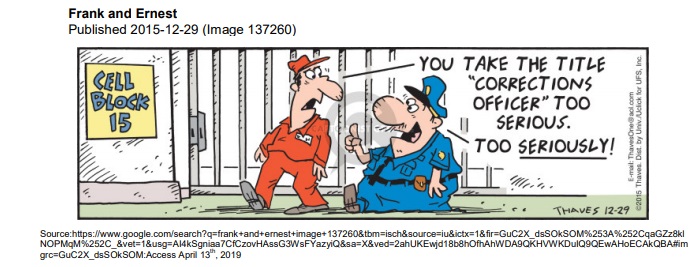Questões de Concurso
Para prefeitura de teresina - pi
Foram encontradas 3.150 questões
Resolva questões gratuitamente!
Junte-se a mais de 4 milhões de concurseiros!
Smiling Can Actually Make People Happier, Study Finds
Researchers of a new study find that the simple act (1)______ smiling can actually make a person happier. Evidently, nearly 50 years of data shows facial expressions can affect an individual’s emotions or feelings.
Emotional Debate
For over 100 years, psychologists have been debating whether facial expressions can affect emotions. The argument became even more pronounced (2)______ 2016 after 17 teams of scientists failed to replicate a popular experiment that would supposedly show that smiling can actually make people happier.
While there are some studies that do not show a relationship (3)______facial expressions and emotional feelings, the researchers of the new study believe that they can’t focus on the data from just one. As such, they scoured data from 138 studies, which tested over 11,000 participants (4)_____ all over the world.
“But we can’t focus on the results of any one study. Psychologists have been testing this idea since the early 1970s, so we wanted to look at all the evidence,” said lead researcher Nicholas Coles, PhD.
Facial Expressions Affect People's Emotions
Based on the team’s meta-analysis, facial expressions do, in fact, have a small impact on emotions. For instance, a person who smiles will feel happier, a person who scowls will feel angrier, and a person who frowns will feel sadder. While the effects aren’t very powerful or long-lasting, it is significant enough to show a correlation.
According to researchers, their findings bring us closer to understanding how human emotions work and how the mind and body work together to shape how we experience emotions. That said, they do note that they are not saying that people can just smile their way to happiness, especially when it comes to mental health conditions such as depression.
The study is published in Psychological Bulletin.
Source: https://www.techtimes.com/articles/241396/20190413/smiling-can-actually-make-peoplehappier-study-finds.htm(adapted)Access: April 13th, 2019
Read the following statements and decide if they are true (T) or false (F) according to the text.
( ) A recent study show that facial expressions can affect individual’s emotion feeling.
( ) The body and mind are interconnected in the way we experience our emotions.
( ) The researchers have believed that the focus can't be either facial expressions or emotional feelings.
( ) People who scowls will never be in good mental health conditions.
The alternative that shows the correct sequence of the statements is
Smiling Can Actually Make People Happier, Study Finds
Researchers of a new study find that the simple act (1)______ smiling can actually make a person happier. Evidently, nearly 50 years of data shows facial expressions can affect an individual’s emotions or feelings.
Emotional Debate
For over 100 years, psychologists have been debating whether facial expressions can affect emotions. The argument became even more pronounced (2)______ 2016 after 17 teams of scientists failed to replicate a popular experiment that would supposedly show that smiling can actually make people happier.
While there are some studies that do not show a relationship (3)______facial expressions and emotional feelings, the researchers of the new study believe that they can’t focus on the data from just one. As such, they scoured data from 138 studies, which tested over 11,000 participants (4)_____ all over the world.
“But we can’t focus on the results of any one study. Psychologists have been testing this idea since the early 1970s, so we wanted to look at all the evidence,” said lead researcher Nicholas Coles, PhD.
Facial Expressions Affect People's Emotions
Based on the team’s meta-analysis, facial expressions do, in fact, have a small impact on emotions. For instance, a person who smiles will feel happier, a person who scowls will feel angrier, and a person who frowns will feel sadder. While the effects aren’t very powerful or long-lasting, it is significant enough to show a correlation.
According to researchers, their findings bring us closer to understanding how human emotions work and how the mind and body work together to shape how we experience emotions. That said, they do note that they are not saying that people can just smile their way to happiness, especially when it comes to mental health conditions such as depression.
The study is published in Psychological Bulletin.
Source: https://www.techtimes.com/articles/241396/20190413/smiling-can-actually-make-peoplehappier-study-finds.htm(adapted)Access: April 13th, 2019
Choose the best alternative to complete the blanks:
Anne was born ___July 2nd, ___the morning ___Germany.
Planet’s ocean-plastics problem detailed in 60-year data set
Researchers find evidence of rising plastic pollution in an accidental source: log books for planktonmonitoring instruments. Matthew Warren
Scientists have uncovered the first strong evidence that the amount of plastic polluting the oceans has risen vastly in recent decades — by analysing 60 years of log books for plankton-tracking vessels.
Data recorded by instruments known as continuous plankton recorders (CPRs) — which ships have collectively towed millions of kilometres across the Atlantic Ocean — show that the trackers have become entangled in large plastic objects, such as bags and fishing lines, roughly three times more often since 2000 than in preceding decades.
This is the first time that researchers have demonstrated the rise in ocean plastics using a single, longterm data set, says Erik van Sebille, an oceanographer at Utrecht University in the Netherlands. “I’m excited that this has been finally done,” he says. The analysis was published on 16 April in Nature Communications.
Although the findings are unsurprising, long-term data on ocean plastics had been scant: previous studies looked mainly at the ingestion of plastic by sea creatures over shorter timescales, the researchers say.
Fishing for data
CPRs are torpedo-like devices that have been used since 1931 to survey plankton populations, by filtering the organisms from the water using bands of silk. Today, volunteer ships such as ferries and container ships tow a fleet of CPRs around the world’s oceans.
(…)Each time a ship tows a CPR, the crew fills in a log book and notes any problems with the device. So Ostle and her colleagues looked through all tow logs from the North Atlantic between 1957 and 2016, to determine whether plastic entanglements have become more common.
Evidence analysis
(…)Van Sebille says that because the study focused on large plastic items, it doesn’t reveal much about the quantity of microplastics — fragments fewer than 5 millimetres long — in the oceans. These tiny contaminants come from sources such as disposable plastic packaging, rather than from fishing gear.
Nevertheless, he adds, the study demonstrates that fisheries play a major part in plastic pollution, and will provide useful baseline data for tracking whether policy changes affect the levels of plastic in the oceans. “As fisheries become more professional, especially in the North Sea, hopefully we might see a decrease,” he says.
Source: https://www.nature.com/articles/d41586-019-01252-0 (adapted).
Access: April 20th, 2019
Planet’s ocean-plastics problem detailed in 60-year data set
Researchers find evidence of rising plastic pollution in an accidental source: log books for planktonmonitoring instruments. Matthew Warren
Scientists have uncovered the first strong evidence that the amount of plastic polluting the oceans has risen vastly in recent decades — by analysing 60 years of log books for plankton-tracking vessels.
Data recorded by instruments known as continuous plankton recorders (CPRs) — which ships have collectively towed millions of kilometres across the Atlantic Ocean — show that the trackers have become entangled in large plastic objects, such as bags and fishing lines, roughly three times more often since 2000 than in preceding decades.
This is the first time that researchers have demonstrated the rise in ocean plastics using a single, longterm data set, says Erik van Sebille, an oceanographer at Utrecht University in the Netherlands. “I’m excited that this has been finally done,” he says. The analysis was published on 16 April in Nature Communications.
Although the findings are unsurprising, long-term data on ocean plastics had been scant: previous studies looked mainly at the ingestion of plastic by sea creatures over shorter timescales, the researchers say.
Fishing for data
CPRs are torpedo-like devices that have been used since 1931 to survey plankton populations, by filtering the organisms from the water using bands of silk. Today, volunteer ships such as ferries and container ships tow a fleet of CPRs around the world’s oceans.
(…)Each time a ship tows a CPR, the crew fills in a log book and notes any problems with the device. So Ostle and her colleagues looked through all tow logs from the North Atlantic between 1957 and 2016, to determine whether plastic entanglements have become more common.
Evidence analysis
(…)Van Sebille says that because the study focused on large plastic items, it doesn’t reveal much about the quantity of microplastics — fragments fewer than 5 millimetres long — in the oceans. These tiny contaminants come from sources such as disposable plastic packaging, rather than from fishing gear.
Nevertheless, he adds, the study demonstrates that fisheries play a major part in plastic pollution, and will provide useful baseline data for tracking whether policy changes affect the levels of plastic in the oceans. “As fisheries become more professional, especially in the North Sea, hopefully we might see a decrease,” he says.
Source: https://www.nature.com/articles/d41586-019-01252-0 (adapted).
Access: April 20th, 2019
Planet’s ocean-plastics problem detailed in 60-year data set
Researchers find evidence of rising plastic pollution in an accidental source: log books for planktonmonitoring instruments. Matthew Warren
Scientists have uncovered the first strong evidence that the amount of plastic polluting the oceans has risen vastly in recent decades — by analysing 60 years of log books for plankton-tracking vessels.
Data recorded by instruments known as continuous plankton recorders (CPRs) — which ships have collectively towed millions of kilometres across the Atlantic Ocean — show that the trackers have become entangled in large plastic objects, such as bags and fishing lines, roughly three times more often since 2000 than in preceding decades.
This is the first time that researchers have demonstrated the rise in ocean plastics using a single, longterm data set, says Erik van Sebille, an oceanographer at Utrecht University in the Netherlands. “I’m excited that this has been finally done,” he says. The analysis was published on 16 April in Nature Communications.
Although the findings are unsurprising, long-term data on ocean plastics had been scant: previous studies looked mainly at the ingestion of plastic by sea creatures over shorter timescales, the researchers say.
Fishing for data
CPRs are torpedo-like devices that have been used since 1931 to survey plankton populations, by filtering the organisms from the water using bands of silk. Today, volunteer ships such as ferries and container ships tow a fleet of CPRs around the world’s oceans.
(…)Each time a ship tows a CPR, the crew fills in a log book and notes any problems with the device. So Ostle and her colleagues looked through all tow logs from the North Atlantic between 1957 and 2016, to determine whether plastic entanglements have become more common.
Evidence analysis
(…)Van Sebille says that because the study focused on large plastic items, it doesn’t reveal much about the quantity of microplastics — fragments fewer than 5 millimetres long — in the oceans. These tiny contaminants come from sources such as disposable plastic packaging, rather than from fishing gear.
Nevertheless, he adds, the study demonstrates that fisheries play a major part in plastic pollution, and will provide useful baseline data for tracking whether policy changes affect the levels of plastic in the oceans. “As fisheries become more professional, especially in the North Sea, hopefully we might see a decrease,” he says.
Source: https://www.nature.com/articles/d41586-019-01252-0 (adapted).
Access: April 20th, 2019
Planet’s ocean-plastics problem detailed in 60-year data set
Researchers find evidence of rising plastic pollution in an accidental source: log books for planktonmonitoring instruments. Matthew Warren
Scientists have uncovered the first strong evidence that the amount of plastic polluting the oceans has risen vastly in recent decades — by analysing 60 years of log books for plankton-tracking vessels.
Data recorded by instruments known as continuous plankton recorders (CPRs) — which ships have collectively towed millions of kilometres across the Atlantic Ocean — show that the trackers have become entangled in large plastic objects, such as bags and fishing lines, roughly three times more often since 2000 than in preceding decades.
This is the first time that researchers have demonstrated the rise in ocean plastics using a single, longterm data set, says Erik van Sebille, an oceanographer at Utrecht University in the Netherlands. “I’m excited that this has been finally done,” he says. The analysis was published on 16 April in Nature Communications.
Although the findings are unsurprising, long-term data on ocean plastics had been scant: previous studies looked mainly at the ingestion of plastic by sea creatures over shorter timescales, the researchers say.
Fishing for data
CPRs are torpedo-like devices that have been used since 1931 to survey plankton populations, by filtering the organisms from the water using bands of silk. Today, volunteer ships such as ferries and container ships tow a fleet of CPRs around the world’s oceans.
(…)Each time a ship tows a CPR, the crew fills in a log book and notes any problems with the device. So Ostle and her colleagues looked through all tow logs from the North Atlantic between 1957 and 2016, to determine whether plastic entanglements have become more common.
Evidence analysis
(…)Van Sebille says that because the study focused on large plastic items, it doesn’t reveal much about the quantity of microplastics — fragments fewer than 5 millimetres long — in the oceans. These tiny contaminants come from sources such as disposable plastic packaging, rather than from fishing gear.
Nevertheless, he adds, the study demonstrates that fisheries play a major part in plastic pollution, and will provide useful baseline data for tracking whether policy changes affect the levels of plastic in the oceans. “As fisheries become more professional, especially in the North Sea, hopefully we might see a decrease,” he says.
Source: https://www.nature.com/articles/d41586-019-01252-0 (adapted).
Access: April 20th, 2019
A figura a seguir mostra uma torre de linha de transmissão de energia com 42 m de altura. Ela é sustentada por cabos de aço que ligam o topo da torre ao solo, formando um ângulo de 30º.
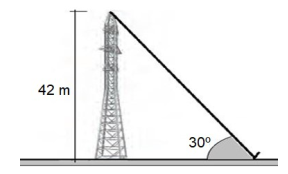
Qual o comprimento, aproximado, do ponto em que o cabo é ligado ao solo, até o topo da torre?
A figura a seguir mostra um triângulo ABC de área igual a 60 cm². O lado AC está dividido em quatro partes iguais, pelos pontos P, Q, R e S, e o lado BC está dividido em três partes iguais, pelos pontos M e N.
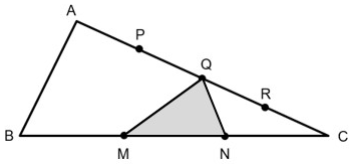
Qual é a área do triângulo QMN?
A figura a seguir representa um prisma reto.

Qual das figuras a seguir é a planificação desse prisma?
Três circunferências são duas a duas tangentes entre si e possuem o mesmo raio, igual a 5 cm, como mostra a figura a seguir.
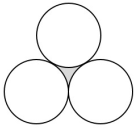
Qual a medida da área cinza formada pelo tangenciamento das três circunferências?
O gráfico a seguir mostra a produção de suco de uma indústria em determinado mês.
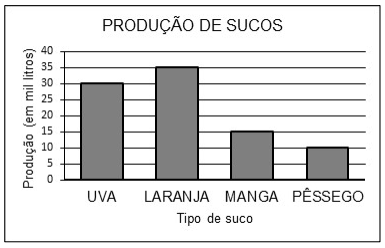
Analisando o gráfico, conclui-se que, do total de sucos produzidos, os de uva e laranja, juntos, representam:
Em uma praça com perímetro igual a 149 m foi feito um caminho paralelo ao lado AB, como mostra a figura.
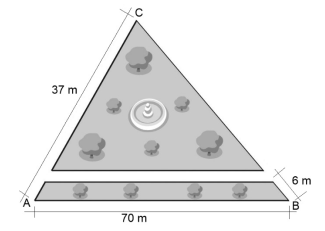
Com base na figura, qual a medida desse caminho?
João tem um terreno e resolveu construir uma casa para sua família, com a condição de que fosse usada, no mínimo, 25% da área do terreno. O terreno está representado no retângulo ABCD, em que AD = 2/3 AB. João demarcou uma área quadrada no vértice D, reservada para a construção de sua residência, onde ED = 1/4 AD.
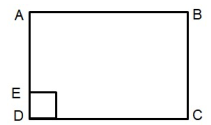
Nesse caso, a área definida por João atingiria exatamente o limite determinado pela condição, se ele

